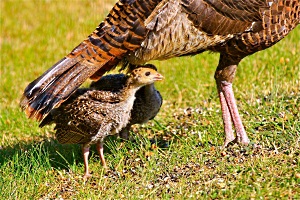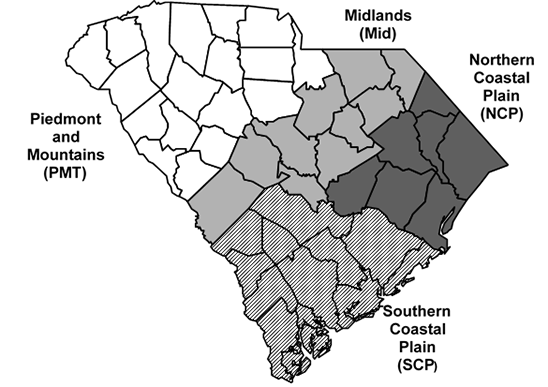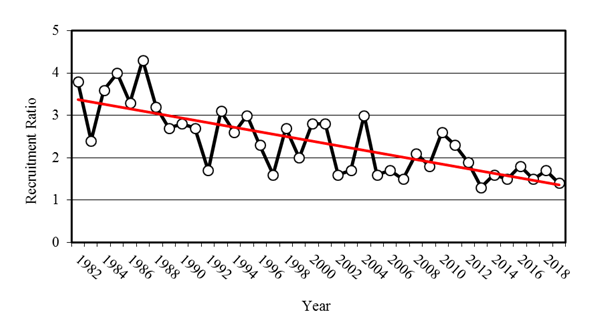Wildlife - Wild Turkeys
2019 Wild Turkey Summer Survey
Wild Turkey Reproduction Continues to be Poor Across the State

Annually since the early 1980's, the S.C. Department of Natural Resources (DNR) has conducted a Summer Turkey Survey to estimate reproduction and recruitment of wild turkeys in South Carolina. The survey involves agency wildlife biologists, technicians and conservation officers, as well as many volunteers from other natural resource agencies and the general public. This year approximately 160 observers recorded 957 unique observations, seeing approximately 6,000 turkeys across the state in July and August. Although wild turkeys nest primarily in April and May in South Carolina, the survey does not take place until late summer. Therefore, the survey statistics document poults (young turkeys) that actually survived and entered the fall population (Table 1).
Wild turkey productivity is assessed by observations of reproduction and associated survival of offspring being recruited into the population. This measure of young entering the population based on the number of hens in the population is the Total Recruitment Ratio (TRR). This annual index is the most practical measure of productivity because it considers successful hens, unsuccessful hens and poult survival. Recruitment of four or more poults per hen is considered excellent, three is good, two is fair and considered a break-even point, and one or less poults per hen is poor. As long as hens are successful at some level, a turkey population can be maintained. However, the goal is to optimize conditions through management applications to promote optimal reproductive success and turkey populations that provide sustainable, quality turkey hunting opportunities into the future. Unlike deer, wild turkeys are much more susceptible to significant fluctuations in reproduction and recruitment. Lack of reproductive success is often associated with bad weather (cold and wet) during nesting and brood rearing season. However, there are a host of predators that take advantage of turkey nests and broods including: raccoons, opossums, skunks, armadillos, snakes, foxes, coyotes, bobcats, feral hogs and numerous avian predators including hawks, owls and crows.
South Carolina has experienced declines in turkey productivity since 1988. Average recruitment prior to 1988 was 3.5 poults per hen. Average recruitment since 1988 has been 2.1, representing a 40 percent decrease in average recruitment. This has been a slow and steady decline with TRR numbers in the 1990’s generally between 2 and 3, but since 2000 numbers below 2.0 have been the norm with levels staying under 2.0 since 2010 (Figure 2). Of particular note, reproduction and recruitment during the last 5 years with a TRR averaging 1.6 has been the lowest since the survey began. This year’s statewide TRR was 1.4. For hens that successfully raise a brood, average brood sizes of 3.5 to 4 poults have remained consistent over time. However, the driving factor in the low productivity is the high percentage of hens that have no poults at all by late summer. Sixty-two percent of hens observed this summer had no poults and that figure has averaged 56% the last five years (Table 2). Hens without poults are considered unsuccessful and either did not attempt to nest, abandoned their nest, lost their nest to predation or human disturbance or had no poults survive due to predation, exposure, starvation, disease or flooding.
These TRR figures consistently below 2.0 are indicative of a shrinking population which does not pair well with increasing hunter numbers and hunter effort. It is also worth noting that turkeys have high reproductive potential and are normally able to maintain populations in spite of predation and weather related factors. Predators and periodic poor weather conditions existed prior to the year 2000 so this more recent and prolonged poor success may be tied to a high number of hens that did not breed successfully or poor fitness, vigor and survival of poults due to genetics, disease, other environmental factors or large scale changes in habitat. Continued research and attention to season timing and other potential contributing factors is needed.
It is also worth noting that both short and long term fluctuations up and down are not unexpected given the reproductive strategy of turkeys and the multiple factors that influence their success and survival. This inherent instability is the reason that annual monitoring is critical for this species.
Anyone interested in participating in the annual Summer Turkey Survey is encouraged to sign-up. The survey period is July 1-August 29 annually and those who participate typically spend a reasonable amount of time outdoors during that time period. Cooperators obviously must be able to identify wild turkeys and must be comfortable in telling the difference between hens, poults, and gobblers. If you would like to participate in the survey, contact Jay Cantrell. You will be added to the cooperator list and receive materials at the end of June annually. Those interested in the survey can also download instructions and survey forms at the following website: https://www.dnr.sc.gov/wildlife/turkey/volunbroodsurvey.html.
Figure 1. Map of physiographic regions for 2019 Summer Turkey Survey.

Table 1. Summary of reproductive data for 2018 Summer Turkey Survey by region.
Region | Gobbler Hen Ratio |
No. Hens w/Poults |
No. Hens w/o Poults (%) |
No. Poults |
Avg. Brood Size |
Total Recruitment Ratio |
|---|---|---|---|---|---|---|
Piedmont |
0.46 |
244 |
444 (65) |
907 |
3.7 |
1.32 |
Midlands |
0.63 |
177 |
126 (42) |
588 |
3.3 |
1.94 |
Northern Coastal |
0.56 |
156 |
245 (61) |
589 |
3.8 |
1.47 |
Southern Coastal |
0.87 |
151 |
358 (70) |
586 |
3.9 |
1.15 |
Statewide |
0.62 |
728 |
1,173 (62) |
2,670 |
3.7 |
1.40 |
Table 2. Statewide Summer Turkey Survey reproductive data 2015-2019
Year |
Gobbler Hen Ratio |
No. Hens w/Poults |
No. Hens w/o Poults (%) |
No. Poults |
Avg. Brood Size |
Total Recruitment Ratio |
|---|---|---|---|---|---|---|
2015 |
0.50 |
1,077 |
1,543 (59) |
3,829 |
3.6 |
1.5 |
2016 |
0.48 |
893 |
1,003 (53) |
3,370 |
3.8 |
1.8 |
2017 |
0.58 |
1,409 |
1,737 (55) |
4,832 |
3.4 |
1.5 |
2018 |
0.62 |
1,076 |
1,206 (53) |
3,948 |
3.7 |
1.7 |
2019 |
0.62 |
728 |
1,173 (62) |
2,670 |
3.7 |
1.4 |
Average |
0.56 |
1,037 |
1,332 (56) |
3,730 |
3.6 |
1.6 |
Figure 2. Summer wild turkey recruitment ratio in South Carolina 1982-2019. Note declining trend since 1988. Average recruitment prior to 1988 = 3.5. Average recruitment since 1988 = 2.1. This represents a 40 percent decrease in average recruitment.

The 2019 Summer Turkey Brood Survey above is provided in Adobe® Acrobat® (PDF) format. Adobe® Reader® is required to open this file and is available as a free download from the Adobe® Web site.
